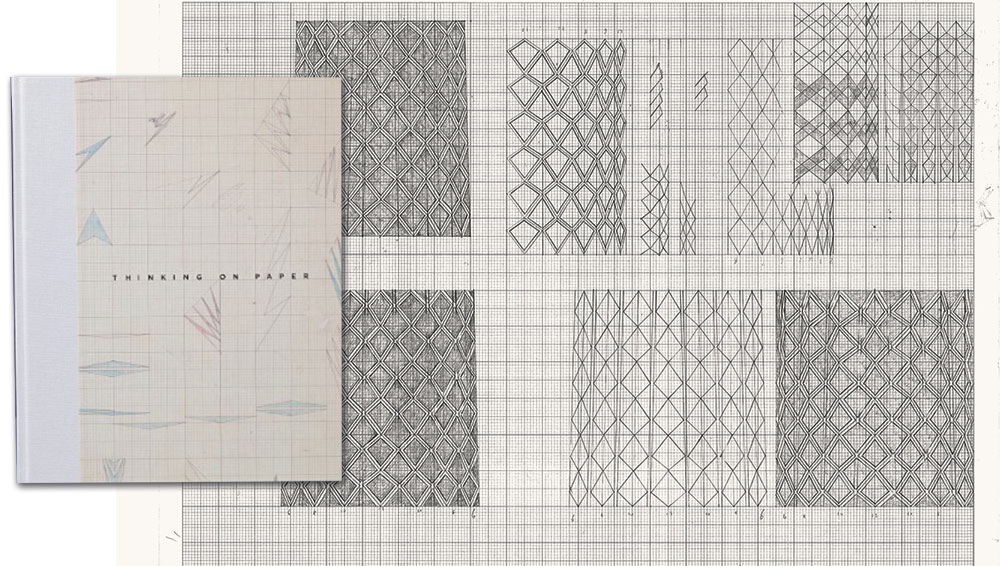
reviewed by JANET McKENZIE
Tess Jaray: Thinking on Paper was published on the occasion of the exhibition Return to Vienna: The Paintings of Tess Jaray, which took place at Vienna Secession earlier this year. The book was commissioned, produced and printed by Secession, as part of a series of artist’s books, and was conceived and designed by the artist’s daughter, the graphic designer Georgia Vaux. The drawings appear chronologically in decades, from 1960-2000, printed actual size and falling off the page without captions, enabling the viewer to be immersed in pencil and graph paper without interruption. Reproduced as found, with rubbings and calculations, the drawings clearly show the mechanisms and thought process of Jaray’s work.
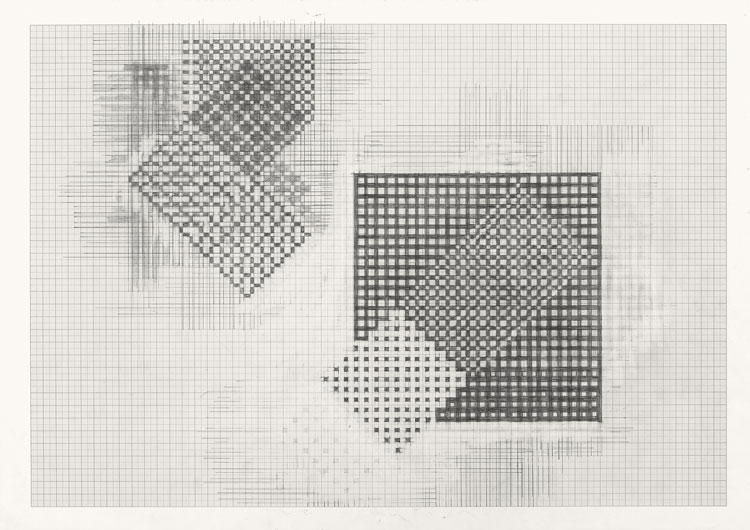
Tess Jaray: Thinking on Paper. Drawings from 1960-2000, pencil and graph paper. Image courtesy the artist.
The publication offers an opportunity to experience the intriguing consummate drawings from one of the most important artists in Britain today. Her work is marked by the refinement and distillation of natural form and architecture; through the work’s immediacy, the drawings presented here share parallels with music. The collection of work from the 60s also prompts an enquiry into how creativity evolves, the importance of the historic context in which an artist develops and the unique development of a singular vision.
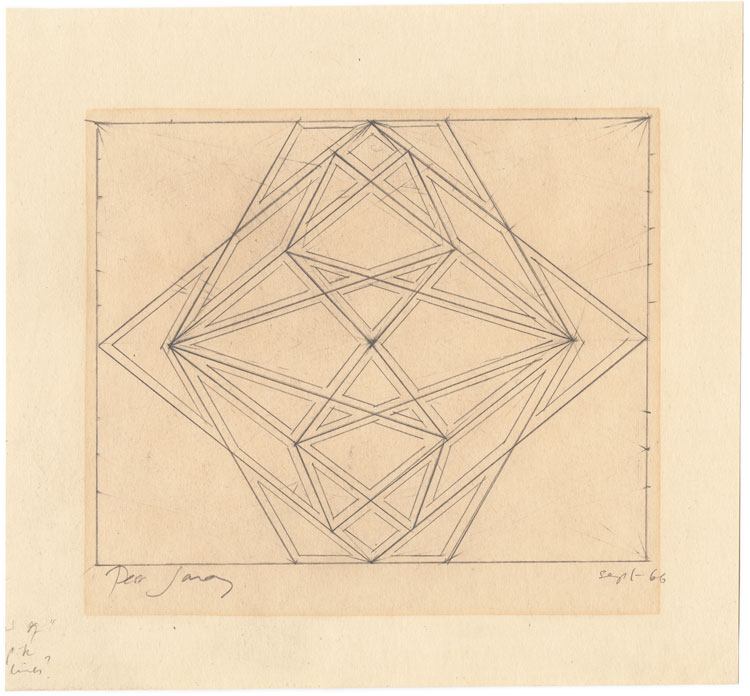
Tess Jaray: Thinking on Paper. Drawings from 1960-2000. Image courtesy the artist.
Influenced in the 50s by American abstract art, her work was given a profound impetus on her first trip to Italy, and particularly by her experience of the architecture there. Architecture provided Jaray with a context in which to explore the formal aspects of space. The intellectual atmosphere of her upbringing – especially in literature, philosophy and music – had already established the need to visualise abstract thought. Jaray describes the creative process as unfathomable, yet she sheds more light on the enigmatic process than any other living artist I can think of. In the foreword to Thinking on Paper, she explains: “The first grownup line of real significance to me was after my travels in Italy in 1960, after leaving the Slade. Italy was then a major cultural shock – this was a time before everyone had a TV, and images were hard to come by. Books on art were a big deal. I was given a travelling scholarship to go and look at Italian paintings, but the impact of the architecture was a truly unexpected and startling surprise. I had never before experienced true awe in a building.”
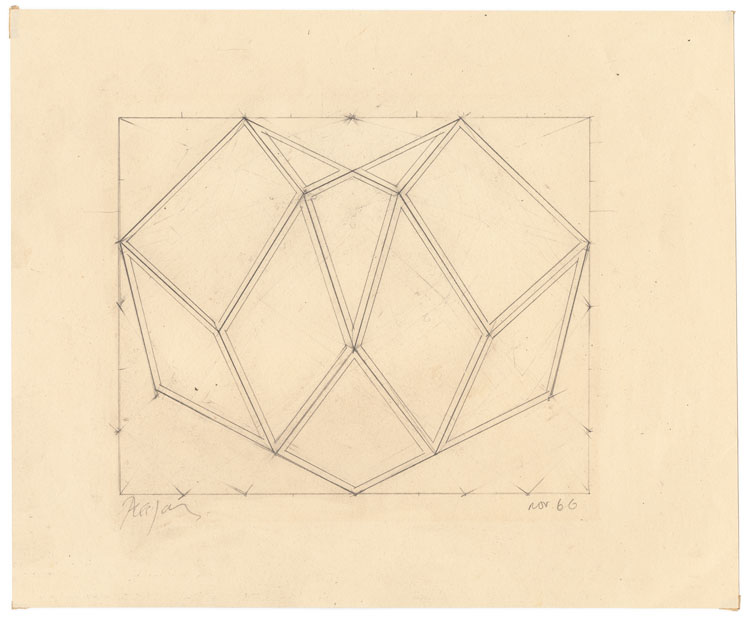
Tess Jaray: Thinking on Paper. Drawings from 1960-2000. Image courtesy the artist.
When she returned to London and to her studio, the young artist aspired to capturing in paint the feeling of awe that she had experienced in places such as the Pantheon in Rome, the Baptistery in Florence, in Venice, or walking along the smallest streets: “I tried all sorts of ways to deal with this. One day I drew a line laterally across the canvas, in the centre. I then drew two more, from top left and at right angles towards the centre, then did the same thing upside down, and there it was, a simple linear description of the kind of space I was searching for, a space that made one feel one was looking up, or into the distance. And it’s possible that this is the basis for everything I have done, over the last 60 years.”
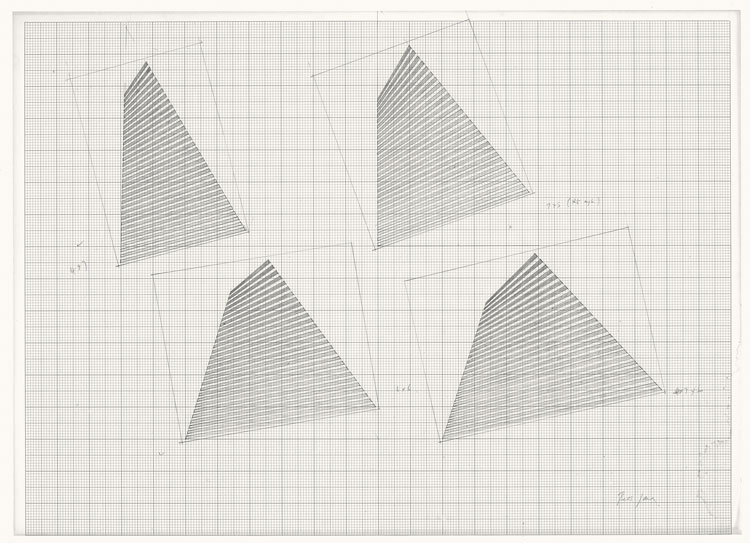
Tess Jaray: Thinking on Paper. Drawings from 1960-2000, pencil and graph paper. Image courtesy the artist.
When I interviewed Jaray in 2019 for Studio International, she explained the impact on her work of Italian architecture in the 60s, as if it were yesterday: “Suddenly seeing, and moving in and around, such great buildings by the likes of Filippo Brunelleschi, Donato Bramante and Leon Battista Alberti was mind-blowing. I didn’t understand what I was seeing, why one should feel so deeply affected by these extraordinary spaces. It took many years before I started to grasp that creating our own space is in many ways how we define ourselves, how we protect ourselves, how we reflect both the world around us and relate our inner selves to that. Even now, I find it hard to really understand the greatness of those architects, and to see that they have never been surpassed. I remember as a small child looking up at cathedral towers and thinking, when I am a grownup I’ll understand how this was done. Well, I never have. But I’m still hopeful, and every mark one makes on a canvas creates some kind of space from which one learns, so perhaps one day.”
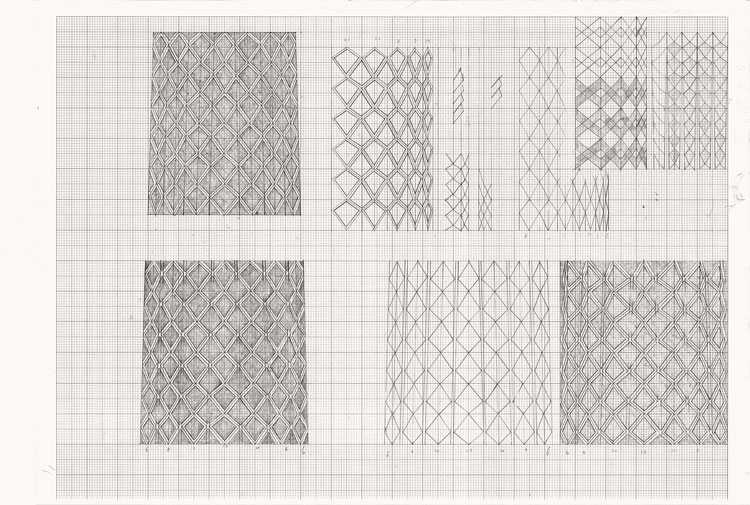
Tess Jaray: Thinking on Paper. Drawings from 1960-2000, pencil and graph paper. Image courtesy the artist.
In the early drawings, the question of scale is addressed. Experimental, but never tentative, there are infinite clues to the means by which the artist can evoke speed, momentum, space and scale. In many drawn images reproduced here, the edges are not defined, and forms move beyond the edges of the page as if they are juggernauts or spaceships, at others the perfect forms are like the patterning in birds’ feathers.
These created places echo constant movement in nature and the creative force of the innate human questioning of unfathomable truths. Why is the finished configuration on this small scale able to evoke the power one experiences when confronted by a very large canvas made up of crumbling earth and clay in an Anselm Kiefer painting; or the sublime effect of a Mark Rothko painting? Or in the compelling cave paintings made millennia ago?
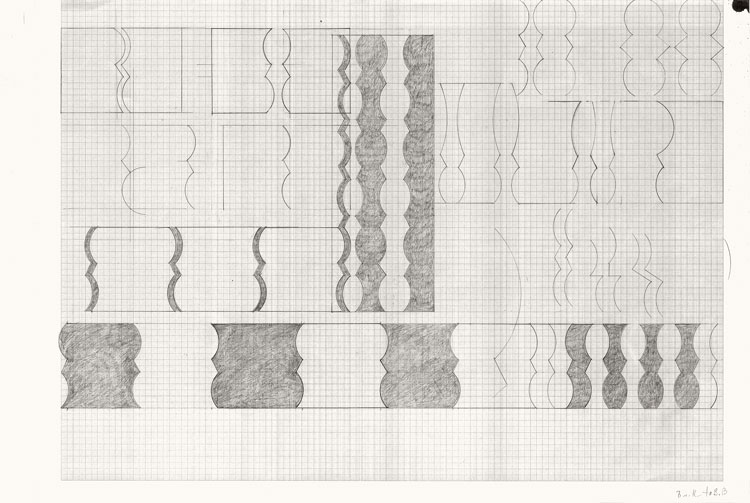
Tess Jaray: Thinking on Paper. Drawings from 1960-2000, pencil and graph paper. Image courtesy the artist.
On first encounter, many of the early drawings indicate an exploratory inscrutability, by virtue of the minimal geometric language employed. As one ponders and examines them, there is a sense of being transported to an abstract world that evokes universal, metaphysical qualities, almost a sense that they are growing before one’s eyes. The quality and range of the effects created is extraordinary for an artist in her 20s. The forms created in pencil on graph paper, evoke infinity, achieved through the fluidity of line and an ability to conjure awe-inspiring architectural structures that were intended to give praise to a higher order. The forms thus created prompt a connection with meditative thought, an attempt to place oneself in the wider world, to be freed of superfluous detail, the commonplace.
Years ago, I experienced reassurance and an articulation of feelings that I was experiencing but had not been able to express, through gazing into the black crumbling layers of a painting by Kiefer. I also felt enlightened by the simple fact that art enabled us to see the deepest mysteries in life and our own subjective experience within a wider perspective and then to make progress. Thinking on Paper throws up a multitude of questions that reminds me of the intellectual generosity of George Steiner’s writings.
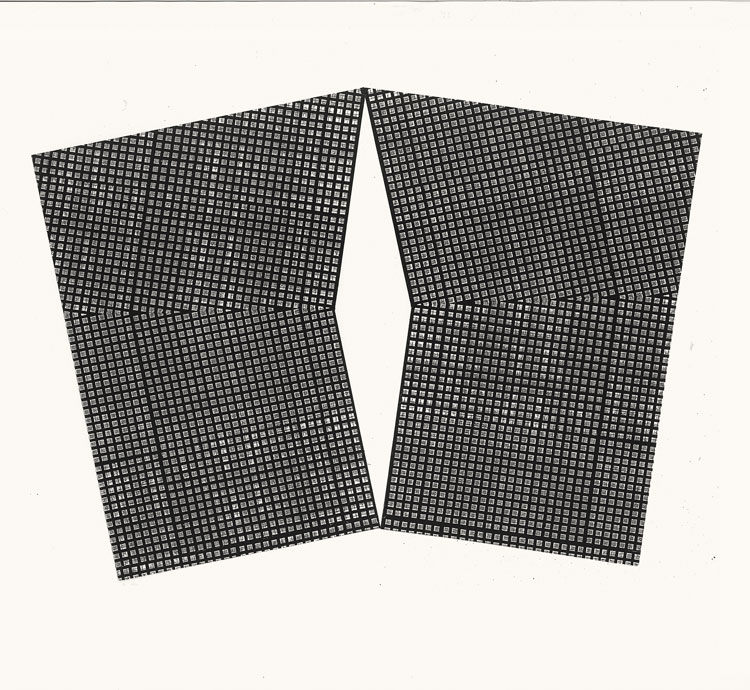
Tess Jaray: Thinking on Paper. Drawings from 1960-2000. Image courtesy the artist.
This sense of infinity, of vastness and generosity is also experienced when reading the remarkable prose of WG Sebald, a formidably visual writer, with whom Jaray collaborated on several projects. In her essay Framing, in Painting: Mysteries and Confessions (2010) she wrote: “The images as I worked on them seemed to me to strongly correspond to the images evoked by Sebald’s prose, by his distortion of and evocation of space, and strange ability apparently to focus both on distance and nearness simultaneously: to make space and memory appear to be the same thing, giving a sense of spinning between past and future.”
She quotes a passage from The Rings of Saturn, in which Sebald wrote about the flight paths of sand martins over the sea and that it evoked childhood memories. “I would imagine,” he wrote, “that the world was held together by the courses they flew through the air.” She responded: “This is what we are always looking for, patterns to make sense of the world. And then we frame them, with bits of paper, film, musical notes, or silence to separate the musical notes, hedges, trees, fences, walls, painted lines, boundaries, buildings, where we are framing air and space, painted frames on paintings like Seurat’s edges, limitations. We try to exclude everything but our own desired bit of the world, separate one part from another, giving emphasis, importance, in order to focus, create a microcosm. Perhaps this is in order to concentrate on a way of retaining the essential. Probably this ‘framed’ moment must, by definition, be transient, but nevertheless it marks us.”
It was her childhood experience in nature where the need to explain and contain that her notational drawings can be seen to evolve. Living in a remote part of Worcestershire, she walked or cycled most days past a damson orchard, carefully laid out in planted rows. In her essay A Drawing Lesson (ibid) she says: “Every time I went past, the astonishing geometry of the rows of trees changed as if magically with each step I took … It was simultaneously a purposeful object, a growing piece of country economics, a lesson in mathematics, a piece of living geometry, a volatile mystery, and a drawing lesson.” After the orchard was destroyed, the artist questions her art practice as possibly “the hope of returning to childhood with its revelation of the new? Or is it rather the hope of replacing loss, by recreation, imitation, of continuing the beat and the rhythm that was part of the orchard in the first place?”
Jaray’s work is also quintessentially of its time. It absorbed the wonderment of astute observation of pattern-making as a child and it was informed by the new languages that were defined in the early 20th century and abstract art in the 50s and 60s. It transcends quotidian life, but it is grounded in observation from nature and the built environment. Jaray first saw Agnes Martin’s work in the 60s and was bowled over by it. To this day, she says, it still resonates more powerfully than perhaps any other contemporary artist. In the interview she explained, “In some of her smaller work on paper, for instance, there really aren’t many clues as to why they are different from any squared-up exercise book, other than the touch of the pen or pencil. But they are, of course, and it’s immediately recognisable. It’s something to do with the transference of spirit to the surface, which can’t really be learned, or contrived. It’s there or it isn’t, and one of the mysteries of art.”
The early drawings are astounding given her tender age. The linear fluidity in terms of engaging with metaphysical experience is evoked by a striving for perfection in terms of pure forms, and their relationship to each other. The skill with which profound sensations can be expressed by tiny shapes – triangles, lozenge-shaped forms, inspire both intimacy and awe. The longer one looks, the deeper the experience. Based on a daily drawing regime, Jaray’s drawings are masterful to contemplate and nourishing to behold.
In the conversation we had about Thinking on Paper, Jaray asserted a number of ideas not unrelated to those Martin Kemp espoused in Visions of Heaven: Dante and the Art of Divine Light. Indeed, where Kemp states that creativity begins where knowledge ends, Jaray asserts that thinking starts where creativity ends. And if drawing is the most immediate form of visual expression, then her precise but often inscrutable drawings beg discussion. All the drawings in the book are constructed of exquisitely precise forms on graph paper with the simplest of implements, the lead pencil. Later in life, Jaray used the computer to draw, to plan vast public projects, such as the forecourt at Victoria station in London, and to plan large paintings. Although she found the magic of it irresistible, these, she says, do not possess the quality of the drawn marks created with pencil. Where she has kept hundreds of the pencil drawings, the computer drawings have been discarded, for although they have been a means to an end, they are not in her view, works in their own right. The computer is a useful tool but lacks human touch and therefore an honesty and integrity in the search for whatever it is that you want to find out.
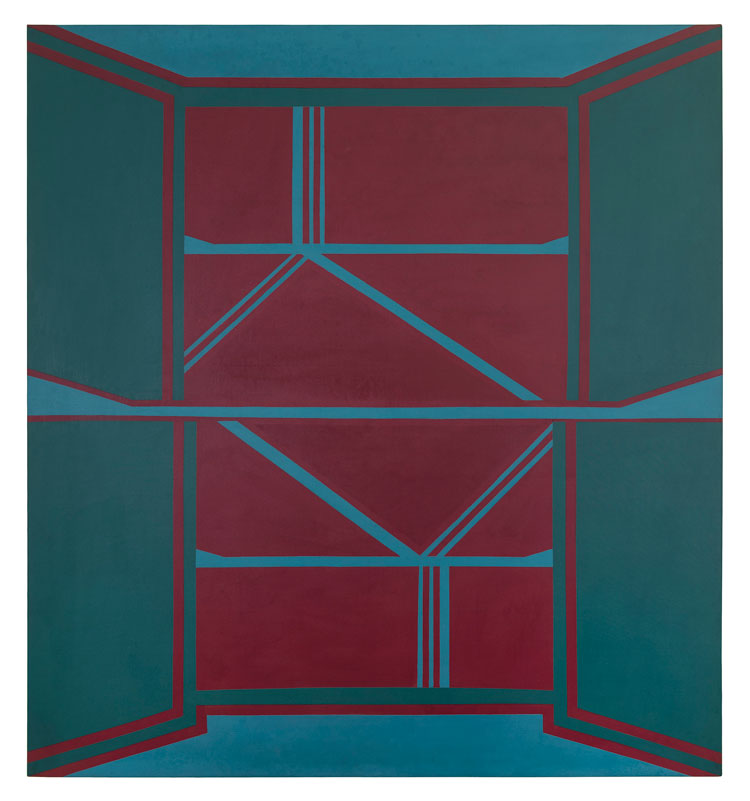
Tess Jaray. Palace Red, 1962. Oil on canvas, 182.9 x 167.6 cm (72 x 66 in). © Tess Jaray. All rights reserved. Courtesy Karsten Schubert London. Purchased with the support of Amis du Centre Pompidou, Cercle International, 2020.
I had the pleasure of talking to the artist while I examined a number of drawings and, as we talked, the drawing in front of me from the 80s took on a new dimension; I saw in it a metaphor for heaven and earth, for transcendence. I had a flashback to Gauguin’s Vision After the Sermon (Jacob Wrestling with the Angel); the shapes in the top half of the picture from left to right with a tall triangle made of segments with an upwards thrust. To the right of the first triangle, there are a further four similar forms that are disappearing off the picture plane, that allude to that moment between being awake and falling asleep, where conscious thought ends and subconscious processes begin. This drifting fluid moment created in visual form, for me, also conjures Chagall’s ladder that can be interpreted as transcending from earthly thought, to the unfathomable in life that artists have always felt a compulsion to understand. In formal terms, Jaray’s drawing explores metaphysics through geometric pure form. The benign forms share an energy that teeter on those of religious symbolism, of juggernaut shapes or art historically from the patterning in Islamic tiles, and from architecture. The drawings represent an intensive year of drawing after Italy before being able to paint again. Even in her 80s, she remains a highly productive artist with recent mesmerising exhibitions in Vienna (Secession), Salisbury (New Art Centre, Roche Court), London (Karsten Schubert) and Paris (Centre Pompidou). The Pompidou exhibition, Elles font l’abstraction, presents female artists’ contributions to abstraction, on a global scale. St Stephen’s Green is one of two Jaray paintings acquired by Centre Pompidou in 2020.
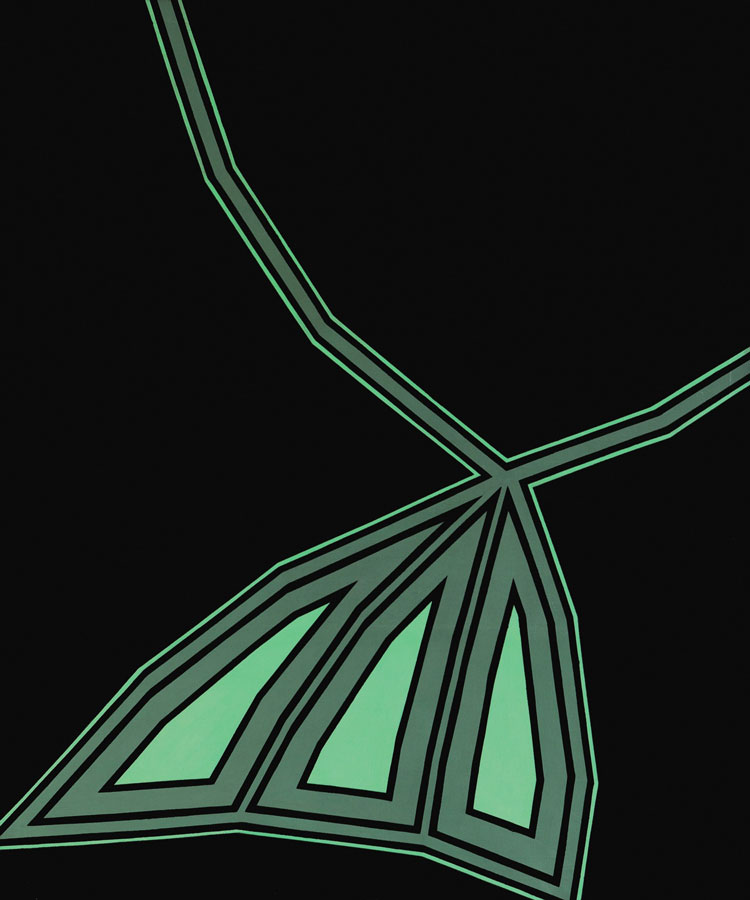
Tess Jaray. St Stephen's Green, 1964. Oil on canvas, 183 x 152 cm (72 1/8 x 59 7/8 in). © Tess Jaray. All rights reserved. Courtesy Karsten Schubert London. Purchased with the support of Amis du Centre Pompidou, Cercle International, 2020.
Like many artists, in childhood, Jaray’s drawings represented a pleasurable activity. She particularly enjoyed drawing enclosed spaces: forms made by the placement of hedges or fences. She looks back on them as a child’s view of geometry, exploring shapes and space, and her parents were accepting of her choices. Drawing, she believes, is a way to find out what happens in the subconscious, to access one’s deepest thoughts, to understand what it is to make sense of one’s own life. It was as natural and necessary for Kazimir Malevich and Wassily Kandinsky in the early years of the 20th century as it was for abstract artists in postwar New York or London, who all sought to create a new language of abstraction, as it was for the creators of cave paintings many millennia ago. The abstracted forms of Jaray resonate with her belief that, as an artist, it is not possible to know what one is exploring at the time, because creativity is an inborn force.
Why, then, does one artist’s image of external form encapsulate something unknowable that nonetheless strikes a chord for the viewer? How is it that we can feel a related emotional excitement, a physical sensation when we encounter a Leonardo or a Rothko, and how does the historic context play into the final product? Thinking on Paper makes a formidable contribution to these eternal mysteries, and it offers rare insight into the creative act and why art is pivotal to our shared humanity.
• Thinking on Paper by Tess Jaray is published by Secession, Vienna, price €35.
• See also: Tess Jaray: Piero Inspirations, published by Ridinghouse, London, price £18.
• Tess Jaray’s work is on show in Elles font l’abstraction (Women in Abstraction), at the Centre Pompidou, Paris, until 23 August 2021, and at the Guggenheim Bilbao from 22 October 2021 to 27 February 2022.